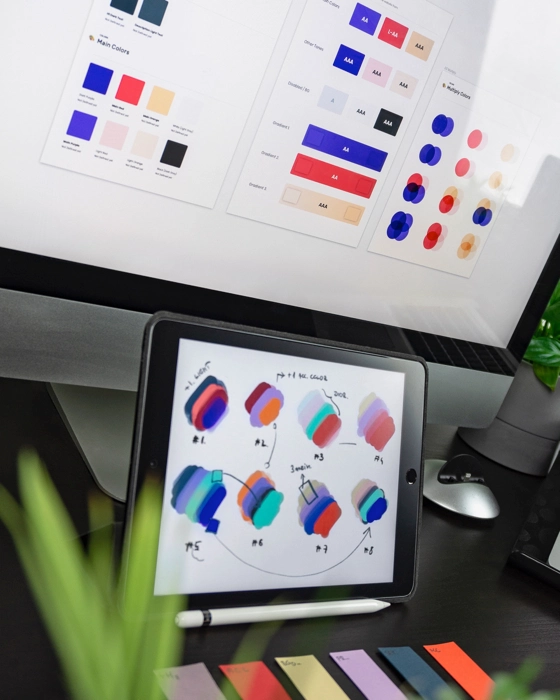Good design is key to a successful website, as it is essential to making a good first impression on visitors. It’s important to create a pleasing aesthetic and ensure that the website is easy to navigate, as this can impact user experience, increase engagement and even contribute to better search engine optimization (SEO).
What’s the Impact of Website Design on Your Business?
A well-designed website can increase user engagement and encourage visitors to explore your site. It can also help improve search engine optimization (SEO) and drive more traffic to the website.
Through good website design, you build trust with potential customers and increase conversions. Visitors should be welcomed to a visually appealing, user-friendly website that they can navigate intuitively. As most people will make a judgment of a business in seconds, having an aesthetically pleasing website that is also easy to use is key to creating a positive first impression.
By investing in good website design, you can ensure that you are well-equipped to compete in the digital realm and capture the attention of potential customers. An attractive website that is also easy to use can make the difference between a customer staying on the site or quickly moving on to the next one. So, if you want to stand out from your competition, make sure that your site is designed accordingly.
What We Mean by “Good Design”
Good design” is easy to use and navigate, while being tailored to the target audience and optimized for all devices, from desktop to mobile. Additionally, good design should be optimized for SEO and accessibility, and be consistent across all pages. The right colors, typography, and imagery should be used to create a website that is both visually appealing and able to easily convey the message of the website.
Usability
Usability is the measure of how easy it is for users to interact with a website, and a website with good usability will have features that are intuitive and easy to use, allowing users to quickly find the information they need. Good usability also helps create a positive user experience, making users more likely to have a good opinion of the website.
From a search engine optimization (SEO) standpoint, usability is also important. Search engine algorithms take into account user experience when determining website rankings, so websites with good usability are more likely to rank higher.
Good design also plays an important role in creating a professional and trustworthy impression of the website. If a website looks outdated or poorly designed, users may be less likely to trust the content of the website or take it seriously. Good design helps to create a good first impression and can be the difference between a user staying on the website or leaving it.
Navigation
Well-planned, intuitive navigation is the key to creating a website that is user-friendly, allowing visitors to find the information they need quickly and easily.
Clear navigation labels and a logical structure are essential to help visitors find the right page quickly, and can also help search engine optimization (SEO). Good navigation not only helps visitors find the information they need, but it also reduces the number of clicks it takes to get to a certain page, reducing user frustration and improving the overall website experience.
A well-designed navigation system can also effectively guide visitors through the website, highlighting your most important content first. Easy-to-understand navigation helps keep visitors on the website longer, increasing page views and reducing the website’s bounce rate.
Conversion
Good design helps to create a positive user experience, which leads to increased user engagement and more conversions. Well-designed websites are more visually appealing and easier to navigate, which helps to capture the visitors’ attention and encourages them to take action. Good design also creates an emotional connection between the user and the website, which can help build trust and loyalty among customers.
Good design plays a critical role in driving conversions for websites. When visitors are presented with a visually appealing and easy-to-navigate website, they are more likely to stay and take action. Good design can also create an emotional connection with the user, which helps to build trust and loyalty. This trust and loyalty can lead to higher conversion rates and more customers. Additionally, good design can improve search engine rankings, as search engines favor websites with strong usability and user experience. By investing in good design, businesses can expect to see an increase in website traffic, engagement, and ultimately, conversions.
Brand Professionalism & Trust
Professional design helps to establish trust and credibility with visitors, creating a positive impression of your brand or company. Quality design is key for making your website stand out from the competition and for making it easier for customers to remember you.
A well-designed website can make navigation and use easier, encouraging visitors to explore your content and take action. Good design also helps ensure that visitors are not overwhelmed or confused by the amount of information or complexity of your website. Professional design helps to create a polished, organized, and user-friendly website that looks well-maintained and helps to build trust with customers and potential customers.
A well-designed website also ensures your visitors have a positive experience when navigating your website and make them feel comfortable enough to take action. A good design also helps visitors find the content they are looking for quickly and easily, reducing any sense of confusion or overwhelm. Professional design can help create a pleasing aesthetic and help to build trust with customers. SEO-focused website design is also important, as it ensures that your website is easily found by potential customers and can help you rank higher in search engine results. Ultimately, good design for websites is an essential part of creating a successful online presence.
Mobile-friendliness
Nowadays, it is essential for websites to be mobile-friendly. With more people accessing the web via smartphones and tablets, having a mobile-friendly website is essential to providing a great user experience. Responsive design is a key component of mobile-friendly websites, as it ensures that the website adjusts to the size of the device it is being viewed on. This allows for a seamless experience regardless of the device.
Not only does having a mobile-friendly website provide a great user experience, it also gives you an edge in search engine results. Mobile-friendly websites tend to rank higher than non-mobile-friendly websites, giving your website a competitive advantage. Additionally, mobile-friendly websites are more likely to convert visitors into customers, since they provide an easy-to-use platform that is optimized for mobile devices and sevices users when and where they want.
SEO
SEO is a key factor in website design, as it helps to ensure that potential customers can easily find your website online. A well-designed website can help to improve your website’s search engine rankings, making it easier for customers to find your website. To further optimize your website for search engines, images, videos, and content should be optimized for search engines.
A clean and organized website design also helps to keep users on your website for longer, which can help to increase conversions. Furthermore, good website design creates a positive user experience, which is key to gaining and retaining customers. Investing in good website design is an essential part of any successful SEO strategy. It is the foundation upon which successful SEO campaigns are built, and it can help to ensure that your website is seen by the right people.
Good website design also plays an important role in how well your website performs in search engine rankings. Well-designed websites are more likely to be crawled and indexed by search engines, which means they are more likely to appear in the search engine results pages (SERPs). This means that it is more likely that potential customers will find your website, which could result in increased website traffic and more conversions. Good website design also makes it easier for users to navigate your website, making it easier to find the information they need. This makes it easier for users to stay on your website and take the desired action, whether it be signing up for an email list, making a purchase, or downloading a white paper. All of these things can help to increase your ROI (return on investment).

